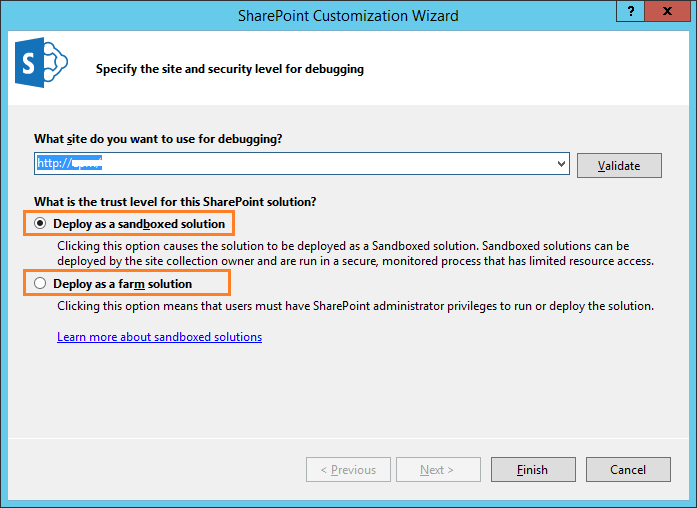In this post, we will list the What’re supported and unsupported elements in Sandbox Solution in SharePoint 2013?

Sandboxed solutions are a feature in SharePoint 2010/2013 that enables site collection users to upload their own custom code solutions.
A sandboxed SharePoint application runs in a secure, monitored process that has access to a limited part of the web farm.
Why Sandboxed Solutions?
In WSS 3.0, solutions could be deployed only to the farm level. This meant that potentially harmful or destabilizing solutions could be deployed that affected the whole Web farm and all of the other site collections and applications that run under it.
However, by using sandboxed solutions, you can deploy your solutions to a subarea of the farm, a specific site collection.
To provide additional protection, the solution’s assembly is not loaded into the main IIS process (w3wp.exe). Instead, it is loaded into a separate process (SPUCWorkerProcess.exe).
This process is monitored and implements quotas and throttling to protect the farm from sandboxed solutions that perform harmful activities, such as running tight loops that consume CPU cycles.
Sandbox Solution Limitations and considerations
- SharePoint runs sandboxed solution code in a process (SPUCWorkerProcess.exe) separate from the main IIS application pool (w3wp.exe) process.
- Sandboxed solutions have a restricted subset of deployable solution elements available to them. Potentially vulnerable SharePoint project templates, such as site definitions and workflows, are not available.
- Types in the Microsoft SharePoint Server 2010 assembly Microsoft.Office.Server cannot be used in sandboxed solutions. Also, only types in the Microsoft SharePoint Foundation 2010 assembly Microsoft.SharePoint can be used in sandboxed solutions.
- Mapped folders cannot be added to the project.
Specifying a SharePoint solution as a sandboxed solution has no effect on the SharePoint server, it only determines how the SharePoint project is deployed to SharePoint and what assemblies it needs to.
Sandboxed solutions support the following capabilities:
- List Definitions
- List Instances
- Onet.xml
- WebTemplate feature elements (instead of Webtemp.xml)
- Content Types/Fields
- Navigation
- Module/files
- Feature callouts
- Web Parts
- Support for all Web Parts that derive from System.Web.UI.WebControls.WebParts.WebPart
- Event receivers
- SPItemEventReceiver
- SPListEventReceiver
- SPWebEventReceiver
- Custom actions
- Declarative workflows
- Visual Web Parts in SharePoint 2013.
Sandboxed solutions do not support the following elements:
- Visual Web Parts in SharePoint 2010.
- Visual Web Parts Farm Only.
- Application Pages
- Custom Action Group
- HideCustomAction element
- Web Application-scoped features
- Farm-scoped features
- Workflows with code
Code-based sandbox solutions are also deprecated in SharePoint 2013 and in SharePoint 2016.
Conclusion
In conclusion we have listed the supported and unsupported elements in sandbox Solution in SharePoint 2013.
Applies To
- SharePoint 2013.
- SharePoint 2010.
